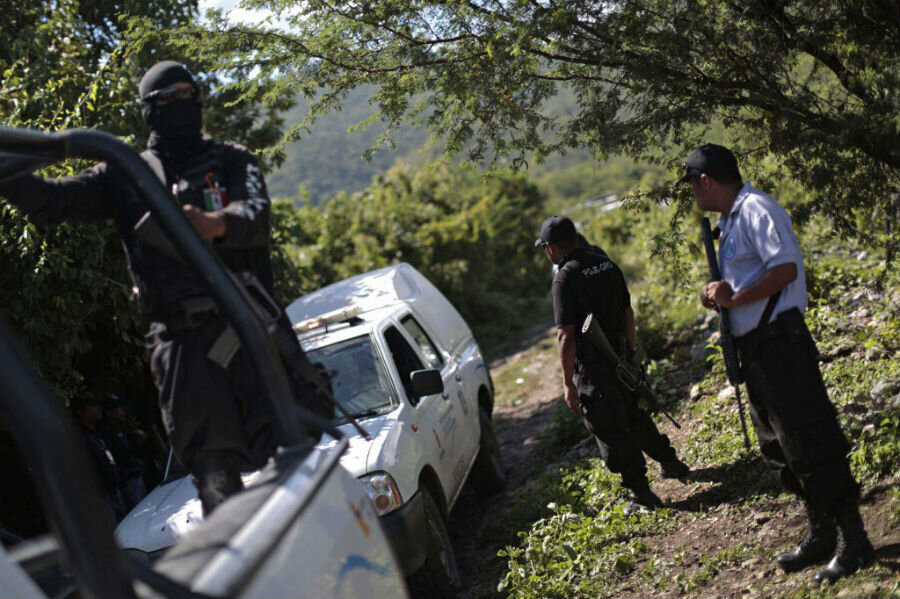Mass grave found in Mexico raising fears it could hold bodies of missing students
Loading...
A mass grave discovered about 120 miles outside Mexico City has raised fears that it could hold some of the 43 Mexican students missing since deadly clashes with police last week. If confirmed, this would be Mexico’s worst known massacre since President Enrique Peña Nieto took office in 2012.
Guerrero State Prosecutor Inaky Blanco at a press conference Saturday night wouldn’t say how many bodies were found in the grave outside the city of Iguala, and cautioned “it would be irresponsible” to assume the bodies were those of students missing since Sept. 26 before DNA tests were completed.
The students went missing last week after a confrontation with Iguala municipal police. Depending on the account, the security officials opened fire as the students sought to hijack buses for transportation or as they were collecting donations for their teacher’s college, reports The New York Times. The Aytozinapa Normal School, attended by the missing students, is known for radical protests that often involve hijacking buses or delivery trucks.
Six people were killed in the confrontation and witnesses say they saw police taking several students away from the scene.
Some 22 police officers were detained after the initial confrontation between the police and students, described by Federal Interior Minister Osorio Chong as an “incredible” display of excessive force by security officials. Another eight people have been arrested, according to the Associated Press, some of whom have been identified as members of organized crime groups.
“The most common hypothesis is that [the missing students] are in the power of organized crime groups that work with Iguala’s municipal police, which is very penetrated by organized crime,” Vidulfo Rosales, a lawyer for a local human rights group, told The Wall Street Journal last week.
Guerrero state, home to Iguala, is one of the poorest and most violent states in Mexico. “In Guerrero, you have a mix of narcos, guerrillas, social conflict, and political bosses,” said Alejandro Hope, a Mexico City-based security analyst.
The disappearances “underscore Mexico’s continuing inability to clean up corrupt local police forces, which officials acknowledge in many areas are in league with the nation’s powerful organized crime groups,” according to a separate Wall Street Journal report.
Working to improve the quality of police is an ongoing, national challenge, reports Fusion.
Across Mexico, municipal and state police departments have been firing hundreds of police officers suspected of having links with drug cartels, or letting go of those who fail to pass quality control and “trustworthiness” exams that include lie detector tests.
These mass firings in state and municipal police forces have forced officials to look for a new generation of candidates….
In Chilpancingo, the capital of the embattled Guerrero state, only 10 people responded to a recent campaign to recruit 140 officers for the municipal police force. To increase applications officials even lowered education requirements for cops, so that even people that only had a middle school education could apply.
In the neighboring state of Michoacan several municipalities have had to disband their entire police forces, including Caracuaro, a town where police officers resigned en masse in 2011 after they were detained and threatened by a local cartel. Law enforcement in these places now depends on a combination of state and federal forces.
"We cannot say anything. We are very nervous, but until they inform us, there is nothing," said father Jesus Lopez, whose 19-year-old son, Giovani, hasn't been seen since the violence last weekend. Mr. Lopez told the AP that a delegation of family and school representatives would go to Iguala today to get information from authorities.
The United Nations has urged Mexican authorities to conduct an "effective and diligent" search for the missing, calling the case "one of the most terrible events of recent times," reports Agence France-Presse.
The discovery of the mass grave comes at a time when Mexico’s human rights record is already under heightened scrutiny. Members of the military were recently charged with homicide in an apparent coverup of a mass execution in southern Mexico earlier this month. The military initially said that 22 people were killed in a shootout, but later eyewitness reports and examination of forensic evidence implied a brazen execution.








